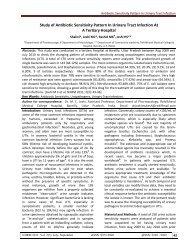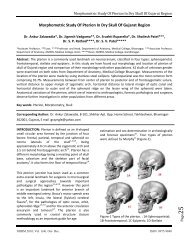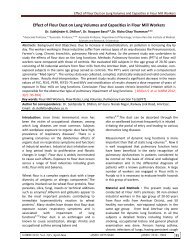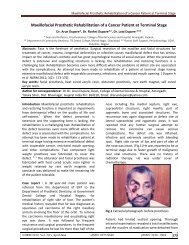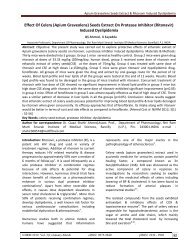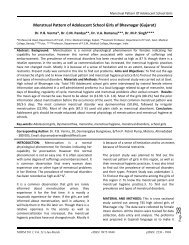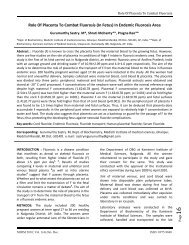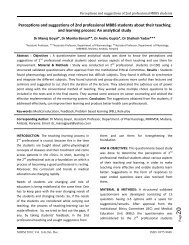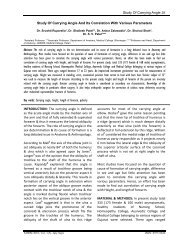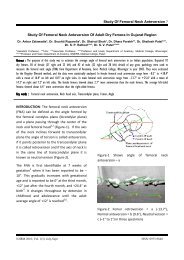Comparative Study of Fenugreek Seeds on Glycemic Index
Comparative Study of Fenugreek Seeds on Glycemic Index
Comparative Study of Fenugreek Seeds on Glycemic Index
You also want an ePaper? Increase the reach of your titles
YUMPU automatically turns print PDFs into web optimized ePapers that Google loves.
<str<strong>on</strong>g>Comparative</str<strong>on</strong>g> <str<strong>on</strong>g>Study</str<strong>on</strong>g> <str<strong>on</strong>g>of</str<strong>on</strong>g> <str<strong>on</strong>g>Fenugreek</str<strong>on</strong>g> <str<strong>on</strong>g>Seeds</str<strong>on</strong>g> <strong>on</strong> <strong>Glycemic</strong> <strong>Index</strong><br />
<str<strong>on</strong>g>Comparative</str<strong>on</strong>g> <str<strong>on</strong>g>Study</str<strong>on</strong>g> <str<strong>on</strong>g>of</str<strong>on</strong>g> <str<strong>on</strong>g>Fenugreek</str<strong>on</strong>g> <str<strong>on</strong>g>Seeds</str<strong>on</strong>g> <strong>on</strong> <strong>Glycemic</strong> <strong>Index</strong> In High And Medium<br />
Dietary Fiber C<strong>on</strong>taining Diets In NIDDM Patients.<br />
Dr. Sampath Kumar V* , **, Dr. Rama Rao J*, Dr. Ambika Devi K*, Dr. Shruti Mohanty**<br />
*Department <str<strong>on</strong>g>of</str<strong>on</strong>g> Biochemistry ,Osmania Medical College, Hyderabad, **Department <str<strong>on</strong>g>of</str<strong>on</strong>g> Biochemistry, Kamineni Institute <str<strong>on</strong>g>of</str<strong>on</strong>g> Medical<br />
Sciences, Narketpally, Nalg<strong>on</strong>da (Dist), India.<br />
Abstracts: Background: Several studies have reported the hypoglycemic property <str<strong>on</strong>g>of</str<strong>on</strong>g> <str<strong>on</strong>g>Fenugreek</str<strong>on</strong>g> seeds<br />
(Trig<strong>on</strong>ella foenum graecum), a comm<strong>on</strong>ly used c<strong>on</strong>diment in Indian homes, due to its high dietary fiber<br />
c<strong>on</strong>tent. Method: A total <str<strong>on</strong>g>of</str<strong>on</strong>g> 25 NIDDM patients were given c<strong>on</strong>trol diets orally c<strong>on</strong>sisting <str<strong>on</strong>g>of</str<strong>on</strong>g> (i)milled<br />
rice(boiled rice),(ii) whole wheat (chapati) experimental diets c<strong>on</strong>sisting <str<strong>on</strong>g>of</str<strong>on</strong>g> (iii) boiled rice with fenugreek seed<br />
powder and (iv) chapati with fenugreek seed powder given <strong>on</strong> four c<strong>on</strong>secutive days. Blood was collected at 0,<br />
15, 30,45,60,90 and 120 minutes. Area under curve and glycemic index was calculated for both c<strong>on</strong>trol and<br />
experimental diets. Results: The mean <str<strong>on</strong>g>of</str<strong>on</strong>g> area under curve <str<strong>on</strong>g>of</str<strong>on</strong>g> rice with fenugreek and wheat with fenugreek<br />
are significantly lower when compared with <strong>on</strong>ly rice and <strong>on</strong>ly wheat taken orally respectively. Further, the<br />
mean glycemic index was significantly lower when fenugreek was given 15 minutes before meal compared to<br />
fenugreek given al<strong>on</strong>g with meal. C<strong>on</strong>clusi<strong>on</strong>: <str<strong>on</strong>g>Fenugreek</str<strong>on</strong>g> has a lowering effect <strong>on</strong> glycemic index when added<br />
to rice and wheat diets, due to delayed gastric emptying and increased intestinal transit time. In additi<strong>on</strong>,<br />
fenugreek decreases glucose absorpti<strong>on</strong> and inhibits starch digesti<strong>on</strong> due to presence <str<strong>on</strong>g>of</str<strong>on</strong>g> soluble fiber and<br />
galactomannans. Adding fenugreek to the diet <str<strong>on</strong>g>of</str<strong>on</strong>g> diabetes patients 15 minutes before the meal causes a<br />
significant reducti<strong>on</strong> in glycemic index and is beneficial to NIDDM patients for l<strong>on</strong>g term c<strong>on</strong>trol <str<strong>on</strong>g>of</str<strong>on</strong>g> their blood<br />
glucose levels and preventi<strong>on</strong> <str<strong>on</strong>g>of</str<strong>on</strong>g> hyperglycaemia related complicati<strong>on</strong>s. [ Sampathkumar V NJIRM 2011;<br />
2(3) : 29-37]<br />
Key Words: <str<strong>on</strong>g>Fenugreek</str<strong>on</strong>g>, glycemic index, Area under curve, c<strong>on</strong>trol and experimental diets.<br />
Author for corresp<strong>on</strong>dence: Dr. Sampath Kumar V, Department <str<strong>on</strong>g>of</str<strong>on</strong>g> Biochemistry, Kamineni Intitute <str<strong>on</strong>g>of</str<strong>on</strong>g> Medical<br />
Sciences, Narketpally, Nalg<strong>on</strong>da (Dist). E-mail: sampath.surya76@gmail.com<br />
Introducti<strong>on</strong>: Diabetes is the third comm<strong>on</strong>est<br />
disease in the world, next to the cardiovascular and<br />
<strong>on</strong>cological disorders .1 . The Internati<strong>on</strong>al Diabetes<br />
Federati<strong>on</strong> Directory, in 1994 showed that the<br />
global burden <str<strong>on</strong>g>of</str<strong>on</strong>g> the disease was estimated at 110<br />
milli<strong>on</strong> and this figure is likely to increase further to<br />
239 milli<strong>on</strong> by 2025 2. . The countries with the<br />
largest number <str<strong>on</strong>g>of</str<strong>on</strong>g> diabetic people will be India,<br />
China and USA by 2030. It is estimated that every<br />
fifth pers<strong>on</strong> with diabetes will be an Indian. The<br />
type – II diabetes is n<strong>on</strong>-insulin dependent and is<br />
the most comm<strong>on</strong> form <str<strong>on</strong>g>of</str<strong>on</strong>g> diabetes and patients<br />
retain endogenous insulin producti<strong>on</strong> but exhibit<br />
excessive adiposity and resistance to peripheral<br />
acti<strong>on</strong> <str<strong>on</strong>g>of</str<strong>on</strong>g> insulin 3 .<br />
The development and progressi<strong>on</strong> <str<strong>on</strong>g>of</str<strong>on</strong>g> microvascular<br />
complicati<strong>on</strong>s is associated closely with<br />
chr<strong>on</strong>ic hyperglycaemia. Therefore, tight glycemic<br />
c<strong>on</strong>trol is by far the most effective approach in the<br />
preventi<strong>on</strong> <str<strong>on</strong>g>of</str<strong>on</strong>g> diabetic vascular complicati<strong>on</strong>s. 4 .<br />
Although euglycaemia can be achieved in diabetes<br />
patients by c<strong>on</strong>venti<strong>on</strong>al insulin and oral<br />
hypoglycaemic drug treatment, microvascular and<br />
neurological complicati<strong>on</strong>s cannot be prevented by<br />
this 5 . Insulin treatment has also been reported to<br />
increase cholesterol synthesis 6 and secreti<strong>on</strong> <str<strong>on</strong>g>of</str<strong>on</strong>g><br />
very low density lipoproteins 7 . Adherence to l<strong>on</strong>g<br />
term carbohydrate restricted diet also leads to the<br />
development <str<strong>on</strong>g>of</str<strong>on</strong>g> insulin resistance and thus serum<br />
cholesterol levels are raised in diabetic patients 8 .<br />
Diet has been recognized as a corner st<strong>on</strong>e in the<br />
management <str<strong>on</strong>g>of</str<strong>on</strong>g> diabetes mellitus. Pers<strong>on</strong>s with<br />
diabetes may get substantial benefits by increasing<br />
their intake <str<strong>on</strong>g>of</str<strong>on</strong>g> dietary fiber 9 . Fiber present in<br />
vegetables, fruits, legumes and fenugreek seed is<br />
soluble in nature and more effective in c<strong>on</strong>trolling<br />
blood sugar and serum lipids than the insoluble<br />
fiber present in cereals and millets 10 .<br />
<str<strong>on</strong>g>Fenugreek</str<strong>on</strong>g> is a leguminous herb, comm<strong>on</strong>ly<br />
cultivated and used as a c<strong>on</strong>diment in India and<br />
North African countries. The seeds are yellow in<br />
colour, bitter to taste 11 and are a rich source <str<strong>on</strong>g>of</str<strong>on</strong>g><br />
fiber. It c<strong>on</strong>tains mucilaginous fiber and total fiber<br />
NJIRM 2011; Vol. 2(3). July- September eISSN: 0975-9840 pISSN: 2230 - 9969 29
<str<strong>on</strong>g>Comparative</str<strong>on</strong>g> <str<strong>on</strong>g>Study</str<strong>on</strong>g> <str<strong>on</strong>g>of</str<strong>on</strong>g> <str<strong>on</strong>g>Fenugreek</str<strong>on</strong>g> <str<strong>on</strong>g>Seeds</str<strong>on</strong>g> <strong>on</strong> <strong>Glycemic</strong> <strong>Index</strong><br />
to the extent <str<strong>on</strong>g>of</str<strong>on</strong>g> 20% and 50% respectively. In<br />
additi<strong>on</strong> it also c<strong>on</strong>tains trig<strong>on</strong>elline, an alkaloid<br />
known to reduce blood glucose level. <str<strong>on</strong>g>Fenugreek</str<strong>on</strong>g><br />
seed powder in the diet reduces blood sugar and<br />
urine sugar with c<strong>on</strong>comitant improvement in<br />
glucose tolerance and diabetic symptoms in both<br />
NIDDM and IDDM. 12 .<br />
Different carbohydrates raise the blood sugar to<br />
variable extents. Glycaemic index indicates the<br />
extent <str<strong>on</strong>g>of</str<strong>on</strong>g> rise in blood sugar in resp<strong>on</strong>se to food in<br />
comparis<strong>on</strong> with the resp<strong>on</strong>se to an equivalent<br />
amount <str<strong>on</strong>g>of</str<strong>on</strong>g> glucose. High carbohydrate and high<br />
fiber diets improve the glucose tolerance and<br />
reduce diabetic symptoms and the dose <str<strong>on</strong>g>of</str<strong>on</strong>g> oral<br />
hypoglycemic drugs required 13 .<br />
In the present study, an attempt has been made to<br />
determine the glycaemic indices <str<strong>on</strong>g>of</str<strong>on</strong>g> Chapati and<br />
Rice (comm<strong>on</strong> Indian recipes) with and without<br />
fenugreek and also to correlate the values <str<strong>on</strong>g>of</str<strong>on</strong>g><br />
glycaemic index and its usefulness in the<br />
management <str<strong>on</strong>g>of</str<strong>on</strong>g> NIDDM.<br />
Material and Methods Selecti<strong>on</strong> <str<strong>on</strong>g>of</str<strong>on</strong>g> subjects:<br />
Twenty five n<strong>on</strong> insulin dependent diabetes<br />
mellitus (NIDDM) subjects diagnosed since two to<br />
ten years, <str<strong>on</strong>g>of</str<strong>on</strong>g> either sex aged between 40 to 60<br />
years were included in the study. Diabetes was<br />
diagnosed <strong>on</strong> the basis <str<strong>on</strong>g>of</str<strong>on</strong>g> WHO criteria 14. All the<br />
patients were <strong>on</strong> oral hypoglycaemic drugs. The<br />
study was c<strong>on</strong>ducted with the approval <str<strong>on</strong>g>of</str<strong>on</strong>g> the<br />
instituti<strong>on</strong>al ethical committee. Patients diagnosed<br />
as diabetes but suffering from gastro intestinal<br />
disorder were excluded from the study.<br />
Nutritive values <str<strong>on</strong>g>of</str<strong>on</strong>g> Prepared test foods: Milled<br />
Rice: 200gm <str<strong>on</strong>g>of</str<strong>on</strong>g> cooked rice c<strong>on</strong>tained 50gm <str<strong>on</strong>g>of</str<strong>on</strong>g><br />
carbohydrates, 4gm <str<strong>on</strong>g>of</str<strong>on</strong>g> proteins, 0.5gm fats and<br />
provided 220kilo calories 15 . Wheat: 103gm <str<strong>on</strong>g>of</str<strong>on</strong>g><br />
chapati c<strong>on</strong>tained 50gm <str<strong>on</strong>g>of</str<strong>on</strong>g> carbohydrates, 10gm <str<strong>on</strong>g>of</str<strong>on</strong>g><br />
proteins, 1.5gm <str<strong>on</strong>g>of</str<strong>on</strong>g> fats and provided 257 kilo<br />
calories 16 . <str<strong>on</strong>g>Fenugreek</str<strong>on</strong>g>: 12.5gm <str<strong>on</strong>g>of</str<strong>on</strong>g> ground whole<br />
fenugreek seed c<strong>on</strong>tained 3.17gm <str<strong>on</strong>g>of</str<strong>on</strong>g> proteins,<br />
0.987gm <str<strong>on</strong>g>of</str<strong>on</strong>g> carbohydrates, 6gm <str<strong>on</strong>g>of</str<strong>on</strong>g> total fiber,<br />
2.5gm <str<strong>on</strong>g>of</str<strong>on</strong>g> gum and 3.5gm <str<strong>on</strong>g>of</str<strong>on</strong>g> Natural detergent<br />
fiber 17 .<br />
germinate and to eliminate the bitter taste, and<br />
then the seeds were dried after removal from the<br />
water, and were ground to a fine powder 18 .<br />
Analytical method: Quantitative determinati<strong>on</strong> <str<strong>on</strong>g>of</str<strong>on</strong>g><br />
whole blood glucose from fresh capillary blood was<br />
d<strong>on</strong>e by the glucometer Accutrend alpha, which is<br />
based <strong>on</strong> glucose – oxidase mediated reacti<strong>on</strong>. 19<br />
Procedure for Meal tolerance test: The Meal<br />
tolerance test (MTT) was c<strong>on</strong>ducted in patients <strong>on</strong><br />
overnight fast both with and without additi<strong>on</strong> <str<strong>on</strong>g>of</str<strong>on</strong>g><br />
ground fenugreek seeds over a period <str<strong>on</strong>g>of</str<strong>on</strong>g> 5 days.All<br />
the studies were begun at 8 am. On the first day,<br />
the fasting blood glucose (0 minute) was estimated<br />
by glucometer and then 50g <str<strong>on</strong>g>of</str<strong>on</strong>g> glucose al<strong>on</strong>g with<br />
250ml <str<strong>on</strong>g>of</str<strong>on</strong>g> water was given orally. After the glucose<br />
c<strong>on</strong>sumpti<strong>on</strong> the blood glucose levels were<br />
estimated again at 15, 30,45,60,90 and<br />
120minutes. On the following four days c<strong>on</strong>trol<br />
and experimental diets (Rice, Wheat and Rice with<br />
fenugreek, wheat with fenugreek) were<br />
administered successively which provided 50<br />
grams <str<strong>on</strong>g>of</str<strong>on</strong>g> carbohydrate.<br />
Day 1 - Oral glucose,<br />
Day 2 - Rice,<br />
Day 3 - Wheat (Chapati),<br />
Day 4 - Rice with fenugreek,<br />
Day 5 - Wheat with fenugreek.<br />
15 subjects were administered <str<strong>on</strong>g>Fenugreek</str<strong>on</strong>g> seed<br />
powder mixed with water and c<strong>on</strong>sumed<br />
15minutes before the meal and 10 subjects were<br />
given the same al<strong>on</strong>g with the meal. All subjects<br />
tolerated the fenugreek without difficulty and no<br />
side effects were reported. Blood glucose levels<br />
were estimated using glucometer by collecting<br />
blood samples at 15, 30, 45, 60, 90 and<br />
120minutes.<br />
Calculati<strong>on</strong> <str<strong>on</strong>g>of</str<strong>on</strong>g> glycaemic index 20 : Area under the<br />
glucose curve and glycaemic index <str<strong>on</strong>g>of</str<strong>on</strong>g> each<br />
preparati<strong>on</strong> was calculated as suggested by<br />
Wolever and Jenkins. The GI value was calculated<br />
to know the extent <str<strong>on</strong>g>of</str<strong>on</strong>g> rise in the blood sugar in<br />
resp<strong>on</strong>se to the test food in comparis<strong>on</strong> with the<br />
resp<strong>on</strong>se to an equivalent amount <str<strong>on</strong>g>of</str<strong>on</strong>g> glucose.<br />
Preparati<strong>on</strong> <str<strong>on</strong>g>of</str<strong>on</strong>g> <str<strong>on</strong>g>Fenugreek</str<strong>on</strong>g> Seed powder: <str<strong>on</strong>g>Fenugreek</str<strong>on</strong>g><br />
seeds were soaked overnight and allowed to<br />
NJIRM 2011; Vol. 2(3). July- September eISSN: 0975-9840 pISSN: 2230 - 9969 30
<str<strong>on</strong>g>Comparative</str<strong>on</strong>g> <str<strong>on</strong>g>Study</str<strong>on</strong>g> <str<strong>on</strong>g>of</str<strong>on</strong>g> <str<strong>on</strong>g>Fenugreek</str<strong>on</strong>g> <str<strong>on</strong>g>Seeds</str<strong>on</strong>g> <strong>on</strong> <strong>Glycemic</strong> <strong>Index</strong><br />
Area under blood glucose resp<strong>on</strong>se curve<br />
for 50g <str<strong>on</strong>g>of</str<strong>on</strong>g> test carbohydrate food.<br />
GI= X 100<br />
Area under blood glucose resp<strong>on</strong>se<br />
for 50g <str<strong>on</strong>g>of</str<strong>on</strong>g> glucose<br />
The method used to calculate the incremental area<br />
under the blood glucose resp<strong>on</strong>se curve is<br />
illustrated in figure1.<br />
Fig 1: General blood glucose resp<strong>on</strong>se curve for<br />
illustrating the method <str<strong>on</strong>g>of</str<strong>on</strong>g> calculati<strong>on</strong> <str<strong>on</strong>g>of</str<strong>on</strong>g> the<br />
incremental area under the blood glucose curve.<br />
It is the sum <str<strong>on</strong>g>of</str<strong>on</strong>g> the areas <str<strong>on</strong>g>of</str<strong>on</strong>g> triangles and<br />
rectangles, calculated geometrically as follows.<br />
Area = At + At + (B-A) t + Bt + (C-B) t --- etc.<br />
2 2 2<br />
Where A,B,C,D,E and F represents the blood<br />
glucose increments, i.e., the differences between<br />
the blood glucose c<strong>on</strong>centrati<strong>on</strong> fasting , and at<br />
times t,2t,3t, 4t, 4t+T and 4t+2T after the start <str<strong>on</strong>g>of</str<strong>on</strong>g><br />
the meal. ‘t’ and ‘T’ represent different time<br />
intervals between blood samples.<br />
As shown in the above fig. 1 the blood glucose<br />
c<strong>on</strong>centrati<strong>on</strong> at F is less than the fasting<br />
c<strong>on</strong>centrati<strong>on</strong>, <strong>on</strong>ly the area represented by the<br />
triangle ET is above the fating level, and therefore<br />
<strong>on</strong>ly this porti<strong>on</strong> is included in the ‘Total’ area. T 1<br />
represents the porti<strong>on</strong> <str<strong>on</strong>g>of</str<strong>on</strong>g> the time interval T when<br />
the blood glucose between E and F is above the<br />
fasting level.<br />
Since E = T 1 , E+F = T<br />
Therefore E T 1 E 2 T<br />
2 2 (E+F)<br />
The overall equati<strong>on</strong> simplifies to<br />
(A + B + C + D) t + (D + E) T + E 2 T<br />
2 2 2 (E + F)<br />
If the last blood glucose c<strong>on</strong>centrati<strong>on</strong>, F, is above<br />
the fasting level, instead <str<strong>on</strong>g>of</str<strong>on</strong>g> below as shown here,<br />
the last term in the equati<strong>on</strong> (namely E 2 T/ 2 (E+F)<br />
becomes E+F) T/2).<br />
Result: Twenty five n<strong>on</strong>-insulin dependent<br />
diabetes mellitus patients (13 male and 12 female)<br />
aged between 40-60 years (50 4 years)<br />
participated in the metabolic study. The diagnosis<br />
<str<strong>on</strong>g>of</str<strong>on</strong>g> diabetes was based <strong>on</strong> WHO criteria and<br />
durati<strong>on</strong> <str<strong>on</strong>g>of</str<strong>on</strong>g> illness varied from 2 to 10 years (5 1.8<br />
years).<br />
In general, both c<strong>on</strong>trol diets (Boiled rice and<br />
chapati) as well as experimental diets (Boiled rice<br />
with fenugreek seed powder and chapati with<br />
fenugreek seed powder) were found to be<br />
acceptable and the diabetic patients had no<br />
difficulty in c<strong>on</strong>suming these diets. Both the<br />
c<strong>on</strong>trol and experimental diets were almost<br />
isocaloric and had similar nutrient compositi<strong>on</strong><br />
except for the fiber c<strong>on</strong>tent which was higher in<br />
the diets c<strong>on</strong>taining fenugreek.<br />
The blood glucose values were analysed at 0, 15,<br />
30,45,60,90 and 120 minutes in NIDDM subjects<br />
with c<strong>on</strong>trol and experimental diets. The mean and<br />
standard deviati<strong>on</strong> values were calculated for<br />
blood glucose values in both c<strong>on</strong>trol and<br />
experimental diets.<br />
Table.1: Blood glucose in NIDDM subjects with<br />
glucose (Standard), c<strong>on</strong>trol and experimental<br />
diets are tabulated as follows.<br />
Time<br />
inter<br />
val<br />
(min)<br />
Blood Glucose values(mg/dl) after oral glucose,<br />
c<strong>on</strong>trol and experimental diets in Mean SD<br />
Glucose Rice Wheat Rice with<br />
fenugreek<br />
Wheat<br />
with<br />
fenugreek<br />
0 161 32 168 28 160 32 155 32 160 24<br />
15 184 36 183 28 172 32 166 35 170 26<br />
30 208 35 204 28 190 30 177 38 181 27<br />
45 240 36 229 31 221 39 193 39 196 30<br />
60 260 39 248 32 237 35 216 39 219 35<br />
90 257 35 247 31 232 38 222 37 221 28<br />
120 232 41 230 30 217 33 212 37 211 26<br />
NJIRM 2011; Vol. 2(3). July- September eISSN: 0975-9840 pISSN: 2230 - 9969 31
<str<strong>on</strong>g>Comparative</str<strong>on</strong>g> <str<strong>on</strong>g>Study</str<strong>on</strong>g> <str<strong>on</strong>g>of</str<strong>on</strong>g> <str<strong>on</strong>g>Fenugreek</str<strong>on</strong>g> <str<strong>on</strong>g>Seeds</str<strong>on</strong>g> <strong>on</strong> <strong>Glycemic</strong> <strong>Index</strong><br />
The mean blood glucose values are relatively lower<br />
with different c<strong>on</strong>trol and experimental diets when<br />
compared to blood glucose levels after glucose<br />
administrati<strong>on</strong> at all the time intervals <str<strong>on</strong>g>of</str<strong>on</strong>g> blood<br />
glucose estimati<strong>on</strong> as depicted in Table 1.<br />
The increases in mean blood glucose<br />
c<strong>on</strong>centrati<strong>on</strong>s and percent increments after<br />
carbohydrate load occurred up to 60minutes with<br />
glucose, rice and wheat and up to 90minutes with,<br />
rice with <str<strong>on</strong>g>Fenugreek</str<strong>on</strong>g> and wheat with <str<strong>on</strong>g>Fenugreek</str<strong>on</strong>g>.<br />
Highest increments occurred up to 45minutes with<br />
glucose, rice and wheat; whereas the same were<br />
observed up to 60minutes with rice with<br />
<str<strong>on</strong>g>Fenugreek</str<strong>on</strong>g> and wheat with <str<strong>on</strong>g>Fenugreek</str<strong>on</strong>g>. Total<br />
increments after various diets were less compared<br />
to those <str<strong>on</strong>g>of</str<strong>on</strong>g> glucose and were also less for<br />
<str<strong>on</strong>g>Fenugreek</str<strong>on</strong>g> c<strong>on</strong>taining diets compared to those<br />
without <str<strong>on</strong>g>Fenugreek</str<strong>on</strong>g>. Delay in occurrence <str<strong>on</strong>g>of</str<strong>on</strong>g> peak<br />
and relatively l<strong>on</strong>ger period for the total<br />
increments are observed with diets c<strong>on</strong>taining<br />
<str<strong>on</strong>g>Fenugreek</str<strong>on</strong>g> as shown in Table 2.<br />
Table 2: Blood Gucose values in both c<strong>on</strong>trol and<br />
experimental diets at various time intervals are<br />
calculated and presented in the following table.<br />
Time<br />
interval<br />
(min)<br />
Glucose<br />
mg/dl<br />
(%)<br />
Rice<br />
mg/dl<br />
(%)<br />
Wheat<br />
mg/dl<br />
(%)<br />
Rice with<br />
<str<strong>on</strong>g>Fenugreek</str<strong>on</strong>g><br />
mg/dl (%)<br />
Wheat<br />
with<br />
<str<strong>on</strong>g>Fenugreek</str<strong>on</strong>g><br />
mg/dl<br />
(%)<br />
15 23(14) 18 (9) 12 (8) 11 (7) 10 (6)<br />
30 24 (13) 21( 11) 18 (10) 11 (7) 11 (6)<br />
45 32 (15) 25 (12) 31 (16) 16 (9) 15 (8)<br />
60 20 (8) 19 (8) 16 (7) 23 (12) 23 (12)<br />
90 - - - 6 (3) 2 (1)<br />
Total<br />
increments<br />
99 83 77 77 61<br />
In order to assess the glycaemic resp<strong>on</strong>ses <str<strong>on</strong>g>of</str<strong>on</strong>g><br />
various carbohydrate loads, blood glucose area<br />
under the curve is calculated by using the formula<br />
<str<strong>on</strong>g>of</str<strong>on</strong>g> Wolever and Jenkins. The mean and standard<br />
deviati<strong>on</strong> values are calculated. The data is<br />
statistically analyzed by using student ‘t’- test. The<br />
mean AUC values with all c<strong>on</strong>trol and experimental<br />
diets are lower than AUC <str<strong>on</strong>g>of</str<strong>on</strong>g> glucose, and this<br />
difference is statistically significant as depicted in<br />
table 3.<br />
Table 3: Comparis<strong>on</strong> <str<strong>on</strong>g>of</str<strong>on</strong>g> mean SD <str<strong>on</strong>g>of</str<strong>on</strong>g> area under<br />
curve (AUC) (mg/dl/min) <str<strong>on</strong>g>of</str<strong>on</strong>g> glucose (standard)<br />
with c<strong>on</strong>trol and experimental diets.<br />
Food Mean SD P<br />
Glucose 8468 648 -<br />
Rice 6731 633
<str<strong>on</strong>g>Comparative</str<strong>on</strong>g> <str<strong>on</strong>g>Study</str<strong>on</strong>g> <str<strong>on</strong>g>of</str<strong>on</strong>g> <str<strong>on</strong>g>Fenugreek</str<strong>on</strong>g> <str<strong>on</strong>g>Seeds</str<strong>on</strong>g> <strong>on</strong> <strong>Glycemic</strong> <strong>Index</strong><br />
fenugreek al<strong>on</strong>g with food (with both rice and<br />
wheat) as shown in Table 5.<br />
Table 5: Mean ± SD , ‘t’ and ‘p’ values <str<strong>on</strong>g>of</str<strong>on</strong>g><br />
glycaemic indices <str<strong>on</strong>g>of</str<strong>on</strong>g> c<strong>on</strong>trol(rice/wheat) and<br />
experimental diet c<strong>on</strong>taining fenugreek<br />
administrated al<strong>on</strong>g with food and 15 minutes<br />
before food<br />
<str<strong>on</strong>g>Fenugreek</str<strong>on</strong>g> <str<strong>on</strong>g>Fenugreek</str<strong>on</strong>g><br />
al<strong>on</strong>g with 15 minutes<br />
Recipe food before food P<br />
Mean SD Mean SD<br />
Rice 79.33 2.12 79.22 3.61 NS<br />
Rice with<br />
fenugreek<br />
69.47 4.21 58.33 4.31
<str<strong>on</strong>g>Comparative</str<strong>on</strong>g> <str<strong>on</strong>g>Study</str<strong>on</strong>g> <str<strong>on</strong>g>of</str<strong>on</strong>g> <str<strong>on</strong>g>Fenugreek</str<strong>on</strong>g> <str<strong>on</strong>g>Seeds</str<strong>on</strong>g> <strong>on</strong> <strong>Glycemic</strong> <strong>Index</strong><br />
tests is represented by their glycaemic resp<strong>on</strong>ses,<br />
which are defined as the incremental area under<br />
the blood glucose resp<strong>on</strong>se curves. It has been<br />
known for many years that different carbohydrate<br />
foods, with the same macro nutrient compositi<strong>on</strong>,<br />
produce different glycaemic resp<strong>on</strong>ses 36 . In the<br />
present study also we found that Rice and Wheat<br />
diets produced different glycaemic resp<strong>on</strong>ses,<br />
wheat having a significantly lower glycaemic<br />
resp<strong>on</strong>se than that <str<strong>on</strong>g>of</str<strong>on</strong>g> rice and both having lower<br />
glycaemic resp<strong>on</strong>ses compared to glucose. We also<br />
observed lowering effects <str<strong>on</strong>g>of</str<strong>on</strong>g> fenugreek <strong>on</strong><br />
glycaemic resp<strong>on</strong>ses, when added to rice and<br />
wheat diets.<br />
As reported earlier by different authors, we also<br />
observed a significant difference in the GI <str<strong>on</strong>g>of</str<strong>on</strong>g><br />
different foods c<strong>on</strong>taining equivalent amount <str<strong>on</strong>g>of</str<strong>on</strong>g><br />
carbohydrate. It has suggested that several factors<br />
such as physical form <str<strong>on</strong>g>of</str<strong>on</strong>g> the preparati<strong>on</strong>, nature <str<strong>on</strong>g>of</str<strong>on</strong>g><br />
cooking, presence <str<strong>on</strong>g>of</str<strong>on</strong>g> anti nutrients, fat, protein,<br />
and dietary fiber influence the GI <str<strong>on</strong>g>of</str<strong>on</strong>g> the particular<br />
food, although the role <str<strong>on</strong>g>of</str<strong>on</strong>g> some <str<strong>on</strong>g>of</str<strong>on</strong>g> these factors is<br />
doubtful. Wheat and rice differ in their c<strong>on</strong>stituent<br />
proteins and lipids 37 .<br />
It has been shown earlier that there is no<br />
correlati<strong>on</strong> between GI and nutrient protein and<br />
fat c<strong>on</strong>tent <str<strong>on</strong>g>of</str<strong>on</strong>g> various preparati<strong>on</strong>s which<br />
indicates that these nutrients cannot influence the<br />
GI. Recently, it has been suggested that the effect<br />
<str<strong>on</strong>g>of</str<strong>on</strong>g> protein and fat <strong>on</strong> GI are not observed unless<br />
they are present in amounts <str<strong>on</strong>g>of</str<strong>on</strong>g> 25g/50g <str<strong>on</strong>g>of</str<strong>on</strong>g><br />
carbohydrate 38 . All the dietary preparati<strong>on</strong>s used in<br />
the study c<strong>on</strong>tained less than 25grams <str<strong>on</strong>g>of</str<strong>on</strong>g> protein<br />
or fat/50grams <str<strong>on</strong>g>of</str<strong>on</strong>g> carbohydrate. Hence the<br />
significant differences in GI observed between rice<br />
and wheat are not due to the differences in their<br />
compositi<strong>on</strong> but due to the different c<strong>on</strong>figurati<strong>on</strong><br />
and different modes <str<strong>on</strong>g>of</str<strong>on</strong>g> preparati<strong>on</strong>. The<br />
unavailable carbohydrate (Dietary fiber) is lower in<br />
rice than that in wheat. The wheat preparati<strong>on</strong><br />
(chapatti) is partially cooked whereas the rice<br />
preparati<strong>on</strong> (Boiled rice) is completely cooked 39 .<br />
The metabolic effects <str<strong>on</strong>g>of</str<strong>on</strong>g> fenugreek seeds may be<br />
divided into acute and chr<strong>on</strong>ic <strong>on</strong>es. Several<br />
authors reported the post prandial glucose<br />
lowering effects <str<strong>on</strong>g>of</str<strong>on</strong>g> fenugreek when administered<br />
c<strong>on</strong>currently and used for some time al<strong>on</strong>g with<br />
the diets. In the present study we observed the<br />
acute effects <str<strong>on</strong>g>of</str<strong>on</strong>g> fenugreek <strong>on</strong> glycaemic resp<strong>on</strong>se<br />
<str<strong>on</strong>g>of</str<strong>on</strong>g> wheat and rice. As reported earlier we also<br />
found significant lowering in GI values <str<strong>on</strong>g>of</str<strong>on</strong>g> both the<br />
foods tested when fenugreek is given al<strong>on</strong>g with<br />
them. The delayed and reduced rise in plasma<br />
glucose, hence the lower glycaemic resp<strong>on</strong>se and<br />
GI values may be due to delayed gastric<br />
emptying 40 , delayed intra luminal glucose<br />
diffusi<strong>on</strong> 41, 42 leading to decreased intestinal transit<br />
time 43,44 or delayed nutrient absorpti<strong>on</strong>. All these<br />
are shown to be the causes <str<strong>on</strong>g>of</str<strong>on</strong>g> low GI exhibited by<br />
various foods in the presence <str<strong>on</strong>g>of</str<strong>on</strong>g> soluble fiber.<br />
Whole fenugreek seeds are the rich sources <str<strong>on</strong>g>of</str<strong>on</strong>g><br />
soluble fiber in the form <str<strong>on</strong>g>of</str<strong>on</strong>g> galactomannans, which<br />
resemble guar gum in chemical structure and<br />
viscosity. Subsequently, it has been shown in<br />
experimental studies that galactomannans derived<br />
from fenugreek seeds has an inhibitory effect <strong>on</strong><br />
starch digesti<strong>on</strong>. Based <strong>on</strong> this informati<strong>on</strong>, it has<br />
been postulated that galactomannan, present in<br />
the fenugreek seeds, may be resp<strong>on</strong>sible for its<br />
hypoglycaemic effect 45 . Recently a French group<br />
isolated 4-hydroxyleucine, a novel amino acid from<br />
fenugreek seeds, which is not present in<br />
mammalian tissues.<br />
It is reported that 4-hydroxy leucine simulates<br />
insulin secreti<strong>on</strong> through a direct acti<strong>on</strong> <strong>on</strong><br />
pancreatic - cells in experimental animals and in<br />
humans 46 . The stimulating effect <str<strong>on</strong>g>of</str<strong>on</strong>g> 4-hydroxy<br />
leucine is strictly glucose dependent and is devoid<br />
<str<strong>on</strong>g>of</str<strong>on</strong>g> any secretory effect under normal<br />
c<strong>on</strong>centrati<strong>on</strong>s <str<strong>on</strong>g>of</str<strong>on</strong>g> glucose, hence the absence <str<strong>on</strong>g>of</str<strong>on</strong>g><br />
risk <str<strong>on</strong>g>of</str<strong>on</strong>g> hypoglycaemia. Besides insulinotrophic<br />
effects, experimental studies c<strong>on</strong>ducted in Zucker<br />
fa/fa rats dem<strong>on</strong>strated that 4- hydroxyl isoleucine<br />
can reduce insulin resistance through activati<strong>on</strong> <str<strong>on</strong>g>of</str<strong>on</strong>g><br />
the early steps <str<strong>on</strong>g>of</str<strong>on</strong>g> insulin signaling in peripheral<br />
tissues and liver, and extend a direct effect by<br />
improving sensitivity to insulin. This may be<br />
especially important in NIDDM patients in whom<br />
insulin resistance predominates. Our present study<br />
supports the beneficial effects <str<strong>on</strong>g>of</str<strong>on</strong>g> fenugreek in<br />
lowering <str<strong>on</strong>g>of</str<strong>on</strong>g> GI through its c<strong>on</strong>stituents <str<strong>on</strong>g>of</str<strong>on</strong>g> soluble<br />
fiber, mainly the galactomannans and 4-<br />
hydroxyleucine.<br />
We observed relatively delayed and comparatively<br />
lower peak and lower total increments <str<strong>on</strong>g>of</str<strong>on</strong>g> blood<br />
NJIRM 2011; Vol. 2(3). July- September eISSN: 0975-9840 pISSN: 2230 - 9969 34
<str<strong>on</strong>g>Comparative</str<strong>on</strong>g> <str<strong>on</strong>g>Study</str<strong>on</strong>g> <str<strong>on</strong>g>of</str<strong>on</strong>g> <str<strong>on</strong>g>Fenugreek</str<strong>on</strong>g> <str<strong>on</strong>g>Seeds</str<strong>on</strong>g> <strong>on</strong> <strong>Glycemic</strong> <strong>Index</strong><br />
glucose c<strong>on</strong>centrati<strong>on</strong>s when fenugreek was taken<br />
with wheat and rice diets as compared to <strong>on</strong>ly<br />
wheat or rice. This may indicate that fenugreek not<br />
<strong>on</strong>ly decreases the hyperglycaemic effect <str<strong>on</strong>g>of</str<strong>on</strong>g> that<br />
particular meal but also <str<strong>on</strong>g>of</str<strong>on</strong>g> the subsequent meals<br />
which will be advantageous to diabetics <strong>on</strong><br />
treatment 47 .<br />
Although significant changes in glycaemic<br />
resp<strong>on</strong>ses are noted when fenugreek is added to<br />
the diet, the glycaemic resp<strong>on</strong>ses however never<br />
completely returned to normal. Hence we str<strong>on</strong>gly<br />
support the view that fenugreek can <strong>on</strong>ly act as an<br />
adjuvant to therapy and cannot replace the insulin<br />
or oral hypoglycaemic drugs.<br />
As it has been shown earlier, additi<strong>on</strong> <str<strong>on</strong>g>of</str<strong>on</strong>g> fenugreek<br />
to prescribed diets in diabetics decreased the<br />
requirement <str<strong>on</strong>g>of</str<strong>on</strong>g> insulin and oral anti diabetic drugs.<br />
It has been reported that the euglycaemia<br />
achieved by c<strong>on</strong>venti<strong>on</strong>al insulin and oral<br />
hypoglycaemic drug treatment could not<br />
completely prevent microvascular and neurological<br />
complicati<strong>on</strong>s. It has been reported that insulin<br />
increases cholesterol synthesis and secreti<strong>on</strong> <str<strong>on</strong>g>of</str<strong>on</strong>g><br />
very low density lipoprotein 48 . Several earlier<br />
reports have shown the beneficial effects <str<strong>on</strong>g>of</str<strong>on</strong>g><br />
fenugreek including those <strong>on</strong> lipid metabolism.<br />
Hence fenugreek supplementati<strong>on</strong> may be much<br />
more beneficial to the diabetics.<br />
The Indian Council <str<strong>on</strong>g>of</str<strong>on</strong>g> Medical Research in 1987<br />
suggested that fenugreek be c<strong>on</strong>sumed in the form<br />
<str<strong>on</strong>g>of</str<strong>on</strong>g> a drink 15minutes before the meals, as it led to a<br />
significantly higher effect <strong>on</strong> blood glucose<br />
resp<strong>on</strong>se than fenugreek given al<strong>on</strong>g with the<br />
food. In the present study we observed a<br />
significant lowering <str<strong>on</strong>g>of</str<strong>on</strong>g> glycaemic index <str<strong>on</strong>g>of</str<strong>on</strong>g> both rice<br />
and wheat when fenugreek is administered<br />
15minutes before the meal compared to fenugreek<br />
given al<strong>on</strong>g with the diet. However, there is no<br />
statistically significant difference in glycaemic index<br />
<str<strong>on</strong>g>of</str<strong>on</strong>g> rice and wheat in these two groups. This<br />
indicates that these two groups <str<strong>on</strong>g>of</str<strong>on</strong>g> diabetic patients<br />
are comparable and hence the significant<br />
difference observed with fenugreek diets is due to<br />
the time <str<strong>on</strong>g>of</str<strong>on</strong>g> fenugreek administrati<strong>on</strong>. It has been<br />
reported that certain dietary fibers like Guargum,<br />
pectin and <str<strong>on</strong>g>Fenugreek</str<strong>on</strong>g> fiber form intra luminal gels.<br />
This leads to delayed carbohydrate absorpti<strong>on</strong> as a<br />
result <str<strong>on</strong>g>of</str<strong>on</strong>g> slower absorpti<strong>on</strong> through these<br />
intraluminal gels. Hence we also c<strong>on</strong>firm and<br />
recommend that the administrati<strong>on</strong> <str<strong>on</strong>g>of</str<strong>on</strong>g> fenugreek<br />
before the regular meal is better than fenugreek<br />
taken al<strong>on</strong>g with the meal.<br />
C<strong>on</strong>clusi<strong>on</strong>: In the present study, it has been<br />
observed that different carbohydrate diets like rice<br />
and wheat give different glycaemic indices. Wheat<br />
(chapati) has a significantly lower glycaemic<br />
resp<strong>on</strong>se when compared to rice because <str<strong>on</strong>g>of</str<strong>on</strong>g> the<br />
higher unavailable carbohydrate c<strong>on</strong>tent in wheat<br />
and also as it is partially cooked. <str<strong>on</strong>g>Fenugreek</str<strong>on</strong>g> has a<br />
lowering effect <strong>on</strong> GI when added to rice and<br />
wheat diets which is attributed to delayed gastric<br />
emptying and increased intestinal transit time,<br />
decreased glucose absorpti<strong>on</strong> and inhibiti<strong>on</strong> <str<strong>on</strong>g>of</str<strong>on</strong>g><br />
starch digesti<strong>on</strong> due to the presence <str<strong>on</strong>g>of</str<strong>on</strong>g> soluble<br />
fiber and galactomannans. Significant lowering <str<strong>on</strong>g>of</str<strong>on</strong>g><br />
GI <str<strong>on</strong>g>of</str<strong>on</strong>g> both rice and wheat were observed when<br />
fenugreek was administered 15minutes before the<br />
meal, when compared to fenugreek given al<strong>on</strong>g<br />
with the diet as this provided time for the<br />
formati<strong>on</strong> <str<strong>on</strong>g>of</str<strong>on</strong>g> intraluminal gels.<br />
The present study c<strong>on</strong>cludes that adding fenugreek<br />
to the diet <str<strong>on</strong>g>of</str<strong>on</strong>g> diabetic patients 15 minutes before<br />
the meal causes a significant reducti<strong>on</strong> in GI and is<br />
beneficial to NIDDM patients for l<strong>on</strong>g term c<strong>on</strong>trol<br />
<str<strong>on</strong>g>of</str<strong>on</strong>g> their blood glucose levels and preventi<strong>on</strong> <str<strong>on</strong>g>of</str<strong>on</strong>g><br />
hyperglycaemic related complicati<strong>on</strong>s.<br />
References:<br />
1. Diabetes Mellitus, WHO Tech Rep Ser 646 ;14,<br />
1980.<br />
2. Vijay Viswanathan, Parthiban :Epidemiology <str<strong>on</strong>g>of</str<strong>on</strong>g><br />
type 2 Diabetes. Manual <str<strong>on</strong>g>of</str<strong>on</strong>g> Diabetes Mellitus for<br />
practiti<strong>on</strong>ers. No.11, jan2008.<br />
3. ICMR Bulletin Vol. 17. No.9, Sept 1987.<br />
4. The diabetes c<strong>on</strong>trol and complicati<strong>on</strong>s trial<br />
research group. The effect <str<strong>on</strong>g>of</str<strong>on</strong>g> intensive<br />
treatment <str<strong>on</strong>g>of</str<strong>on</strong>g> diabetes <strong>on</strong> the development and<br />
progressi<strong>on</strong> <str<strong>on</strong>g>of</str<strong>on</strong>g> l<strong>on</strong>g term complicati<strong>on</strong>s in NIDDM.<br />
N. Engl. J. Med. 1993:329, 977-86.<br />
5. 5. Pirart J: Diabetes mellitus and its degenerative<br />
complicati<strong>on</strong>s. A Prospective study <str<strong>on</strong>g>of</str<strong>on</strong>g> 4400<br />
patients observed between 1947 and 1973.<br />
Diabetes care1:168,1978.<br />
6. Bhathena S.J, Avigan J, and Sehreiner M.E: Effect <str<strong>on</strong>g>of</str<strong>on</strong>g><br />
NJIRM 2011; Vol. 2(3). July- September eISSN: 0975-9840 pISSN: 2230 - 9969 35
<str<strong>on</strong>g>Comparative</str<strong>on</strong>g> <str<strong>on</strong>g>Study</str<strong>on</strong>g> <str<strong>on</strong>g>of</str<strong>on</strong>g> <str<strong>on</strong>g>Fenugreek</str<strong>on</strong>g> <str<strong>on</strong>g>Seeds</str<strong>on</strong>g> <strong>on</strong> <strong>Glycemic</strong> <strong>Index</strong><br />
insulin <strong>on</strong> chosterol and fatty acid synthesis and<br />
HMG CO A redcutase activity in mammalian cells<br />
grown in culture. Proc. Natl. Acad Sci 71:2174,<br />
1974.<br />
7. Revan G.M and Bernstein R.M: Effect <str<strong>on</strong>g>of</str<strong>on</strong>g> obesity <strong>on</strong><br />
the Relati<strong>on</strong>ship between very low density<br />
lipoprotein producti<strong>on</strong> rate and plasma triglyceride<br />
c<strong>on</strong>centrati<strong>on</strong> in normal and hyper triglyceridemic<br />
subjects.Metabolism 27; 1047, 1978.<br />
8. Pedersen O. Hjollund E, Lind Skov. H. O, Helms P.<br />
Sorenen N.S and Ditzel. J: Increased insulin<br />
receptor binding to m<strong>on</strong>ocytes from insulin<br />
dependent diabetes patients after a low fat, high<br />
starch, high fiber diet. Diabetes care 5; 284, 1982.<br />
9. ICMR Bulletin 17; 9, 1987.<br />
10. T.C. Raghuram, Swaran pasricha and R.D. Sharma:<br />
Diet and Diabetes, 1993. P.10.<br />
11. Mishkinsky J. Joseph B and Sulman F:<br />
Hypoglycaemic effect <str<strong>on</strong>g>of</str<strong>on</strong>g> trig<strong>on</strong>elline.<br />
Lancet1;1311, 1967.<br />
12. T.C. Raghuram, Swaran paricha R.D. Sharma :Diet<br />
and Diabetes 1993,P.19.<br />
13. T.C. Raghuram, Swaran Parricha R. D. Sharma: Diet<br />
and Diabetes, 1993; P. 26<br />
14. Definiti<strong>on</strong> and Diagnosis <str<strong>on</strong>g>of</str<strong>on</strong>g> Diabetes Mellitus and<br />
Intermediate hyperglycaemia - A report <str<strong>on</strong>g>of</str<strong>on</strong>g> a<br />
WHO/IDF C<strong>on</strong>ltati<strong>on</strong> World Health Organisati<strong>on</strong><br />
;2006.<br />
15. T.C. Raghuram Swaran Parsicha and R.D. Sharma<br />
Diet and Diabetes: P 56:1993.<br />
16. T.C. Raghuram Swaran Parsicha and R.D. Sharma<br />
Diet and Diabetes : P 40:1993.<br />
17. P. Udaya Sekhara Rao and R.D. Sharma. : An<br />
evaluati<strong>on</strong> <str<strong>on</strong>g>of</str<strong>on</strong>g> protein quality <str<strong>on</strong>g>of</str<strong>on</strong>g> fenugreek seeds<br />
(T. foenum graceum) and their supplementary<br />
effects.Food chemistry 24;1-9;1987.<br />
18. T.C. Raghuram Swaran Parsicha and R. D. Sharma<br />
Diet and Diabetes: P33:1993.<br />
19. Test strips for quantitative determinati<strong>on</strong> <str<strong>on</strong>g>of</str<strong>on</strong>g> whole<br />
blood glucose from fresh capillary blood: Roche<br />
diagnostics, East Sussex, BN7 1LG, United Kingdom.<br />
20. Thomas MS Wolewer and David JA Jenkins. The use<br />
<str<strong>on</strong>g>of</str<strong>on</strong>g> the glycaemic index in prediciting the blood<br />
glucose resp<strong>on</strong>se to mixed meals. Am. J. Clin. Nutr.<br />
43;167-172:1986.<br />
21. Collier E., Watkins<strong>on</strong> A., Cleland CF, Roth J. Partial<br />
purificati<strong>on</strong> and characterizati<strong>on</strong> <str<strong>on</strong>g>of</str<strong>on</strong>g> an insulin like<br />
material from Spinach and Lemna Gibba G3. J. Biol.<br />
Chem. 262:6238-47:1987.<br />
22. Shanmuga Sundaram E.R., Gopith K.L., Radha S.K.,<br />
Rajendran V.M., possible regenerati<strong>on</strong> <str<strong>on</strong>g>of</str<strong>on</strong>g> the islets<br />
<str<strong>on</strong>g>of</str<strong>on</strong>g> Langerhans in Streptozotocin-diabetic rats given<br />
gymnema sylvestere leaf extract. J. Ethnopharm<br />
30;265-89:1990.<br />
23. Abdel M.A., EL- Feki, SALAM E., Effect <str<strong>on</strong>g>of</str<strong>on</strong>g> Nigella<br />
Stative, Fish Oil and Gliclazide <strong>on</strong> alloxa diabetic<br />
rates, Biochemical and Histopathological studies.<br />
J. Egy. Ger. Scoi. Zool 23:237-65:1997.<br />
24. Nels<strong>on</strong> R.W., Ihle S.L., Lewis LD., Salisbury SK.,<br />
Bottoms G.D., Effects <str<strong>on</strong>g>of</str<strong>on</strong>g> dietary fiber<br />
supplementati<strong>on</strong> <strong>on</strong> glycaemic c<strong>on</strong>trol in dogs with<br />
alloxam induced diabetes mellitus. Am. J. Vet.<br />
Res.52;2060-6:1991.<br />
25. Zecharia Madar and Richard Thorne: Dietary fiber.<br />
Progress in food and nutriti<strong>on</strong> science 11; 153 –<br />
174: 1987.<br />
26. Rao P.U, Sesikeran, B.Rao , P.S et al : short term<br />
nutriti<strong>on</strong>al and safety evaluati<strong>on</strong> <str<strong>on</strong>g>of</str<strong>on</strong>g> fenugreek.<br />
Nutr. Res. 16; 1495-505:1936.<br />
27. Flammang, A.M., Cif<strong>on</strong>e M.A., Erexs<strong>on</strong> G.L.<br />
Stankowski L.., Jr; Genotoxicity testing <str<strong>on</strong>g>of</str<strong>on</strong>g> a<br />
fenugreek extract. Food Chm. Toxicol 42;1769-75;<br />
2004.<br />
28. Sharma R.D., Sarkar. A., Hazra., D.K., et al :<br />
Toxicological evaluati<strong>on</strong> <str<strong>on</strong>g>of</str<strong>on</strong>g> fenugreek seeds; al<strong>on</strong>g<br />
term feeding experiment in diabetic patients<br />
phyotherapy Res, 10:519-20, 1996.<br />
29. R.D. Sharma: Effect <str<strong>on</strong>g>of</str<strong>on</strong>g> fenugreek seeds and leaves<br />
<strong>on</strong> blood glucose and serum insulin resp<strong>on</strong>ses in<br />
human subjects. Nutr. Res. 6;1353-64;1986.<br />
30. Sharma and T.C. Raghuram: Hypoglycaemic effect<br />
<str<strong>on</strong>g>of</str<strong>on</strong>g> fenugreek seeds in n<strong>on</strong>- insulin dependent<br />
diabetic subjects. Nutr. Res. 10;731-739,1990.<br />
31. Sharma, T.C. Raghuram, and N. Sudhakar Rao.<br />
Effect <str<strong>on</strong>g>of</str<strong>on</strong>g> fenugreek seeds <strong>on</strong> blood glucose and<br />
serum lipids in type I diabetes Eur. J. Clin. Nutr. 44;<br />
301-306., 1990.<br />
32. Zecharia Madar., Rachel Abel., Shlomith Samish<br />
and Joseph Arad. Glucose lowering effect <str<strong>on</strong>g>of</str<strong>on</strong>g><br />
fenugreek in n<strong>on</strong>- insulin dependent diabetes. Eur.<br />
J. Clin. Nutr. 42; 51-54;1988.<br />
33. Jane H Yo<strong>on</strong>., Lilian U Thomps<strong>on</strong> and Jenkins. The<br />
effect <str<strong>on</strong>g>of</str<strong>on</strong>g> phytic acid <strong>on</strong> in vitro rate <str<strong>on</strong>g>of</str<strong>on</strong>g> starch<br />
digestibility and blood glucose resp<strong>on</strong>se. Am. J.<br />
Clin. Nutr.38;835-842:1983.<br />
34. James W. Anders<strong>on</strong> and Wen- Julin Chen. Plant<br />
fiber carbohydrate and lipid metabolism .Am. J.<br />
Clin. Nutr. 32;346-363:1979.<br />
35. Wells. A.F., and B.H. Ersh<str<strong>on</strong>g>of</str<strong>on</strong>g>f <str<strong>on</strong>g>Comparative</str<strong>on</strong>g> effects <str<strong>on</strong>g>of</str<strong>on</strong>g><br />
pertin N.F, Administrati<strong>on</strong> <strong>on</strong> the cholesterol – fed.<br />
NJIRM 2011; Vol. 2(3). July- September eISSN: 0975-9840 pISSN: 2230 - 9969 36
<str<strong>on</strong>g>Comparative</str<strong>on</strong>g> <str<strong>on</strong>g>Study</str<strong>on</strong>g> <str<strong>on</strong>g>of</str<strong>on</strong>g> <str<strong>on</strong>g>Fenugreek</str<strong>on</strong>g> <str<strong>on</strong>g>Seeds</str<strong>on</strong>g> <strong>on</strong> <strong>Glycemic</strong> <strong>Index</strong><br />
Rabbit, Guinea Pig, Hamster and Rat. Proc. Soc.<br />
Exp. Bio. Med 111;147:1962.<br />
36. T.C. Raghuram, R.D. Sharma., S. Pasricha. K.K.<br />
Men<strong>on</strong> and G. Rdhaiah Glycaemic India <str<strong>on</strong>g>of</str<strong>on</strong>g><br />
fenugreek recipes and its relati<strong>on</strong> to dietary fiber<br />
INTL. J. Diab. Dev. Countries Vol 12;p1-4, (1992).<br />
37. Ross S.W, Brand J.C, Thorburn A.W, Truswell A.C:<br />
Glycaemic index <str<strong>on</strong>g>of</str<strong>on</strong>g> processed wheat products.Am.<br />
J. Clin. Nutr. 46;6361-635:1987.<br />
38. Jenkins D.J.A., Rainey – Mac D<strong>on</strong>ald CG., Benn G.<br />
Fiber in the treatment <str<strong>on</strong>g>of</str<strong>on</strong>g> hyperlipidemia. In: Spiller<br />
G.Ed.Handbook <str<strong>on</strong>g>of</str<strong>on</strong>g> dietary fiber in human nutriti<strong>on</strong>.<br />
Boca Rat<strong>on</strong>. CRC Press Inc. 327-44.1986.<br />
39. Wolever TMS., Jenkinsd. J.A., Jenkinsa. G., Vuksan.<br />
V., W<strong>on</strong>g. G., Josse R.G. Effect <str<strong>on</strong>g>of</str<strong>on</strong>g> ripeness <strong>on</strong> the<br />
glycaemic resp<strong>on</strong>se to banana J. Clin.. Nutr.<br />
Gastroenterol 3;85-8:1988.<br />
40. Edwards C.A., Black burn N.A., Craigen L. et al:<br />
Viscosity <str<strong>on</strong>g>of</str<strong>on</strong>g> food gums determined in vitro related<br />
to their hypoglycaemic acti<strong>on</strong>s. Am. J. Clin. Nutr.<br />
46; 72-7;1987.<br />
41. Jenkins DJA., Jenkins MJA., Wolever TMS., Taylor<br />
R.H., Ghafari H.: Slow release carbohydrate:<br />
Mechanism <str<strong>on</strong>g>of</str<strong>on</strong>g> acti<strong>on</strong> <str<strong>on</strong>g>of</str<strong>on</strong>g> visi<strong>on</strong>s fibers. J. Clin.. Nutr.<br />
Gastroenterol 1;237-41;1986.<br />
42. Jenkins DJA., Wolever TMS., Taylor R.H., Barker<br />
Excepti<strong>on</strong>ally low blood glucose resp<strong>on</strong>se to dried<br />
beans. Comparis<strong>on</strong> with other carbohydrate foods.<br />
Br. Med. J. 2:578-80:1980.<br />
43. M<strong>on</strong>nier L. Pham T.C., Aguirre. L., Orsetti. A<br />
Influence <str<strong>on</strong>g>of</str<strong>on</strong>g> indigestible fibers <strong>on</strong> glucose tolerance<br />
Diabetes care 1;83-88;1978.<br />
44. Yo<strong>on</strong> J.H., Thomps<strong>on</strong> L.U., Jenkinsd. J.A., The effect<br />
<str<strong>on</strong>g>of</str<strong>on</strong>g> Phytic acid <strong>on</strong> in vitro rate <str<strong>on</strong>g>of</str<strong>on</strong>g> starch digestibility<br />
and blood glucose resp<strong>on</strong>se Am. J. Clin. . Nutr.<br />
38;835-42;1983.<br />
45. T.C. Raghuram ; <str<strong>on</strong>g>Fenugreek</str<strong>on</strong>g>- the w<strong>on</strong>der seed in<br />
Disease Management. Nutr. Dis. Management<br />
26;7-14:2005.<br />
46. Staub. H., Untersuchungen uber den zudkerst<str<strong>on</strong>g>of</str<strong>on</strong>g>f<br />
vechsel des munchen. % Kun. Med. 91;44-8:1921.<br />
47. Bhatchena. S.J., Avigan. J., Schreiner. M.E. Effect <str<strong>on</strong>g>of</str<strong>on</strong>g><br />
insulin <strong>on</strong> sterol and fatty acid synthesi and HMG<br />
CoA redcutase activity in mammalian cells grown<br />
in culture Proc. Natc. Acad. Sci. 71; 2174:1974.<br />
48. Reaven. G.M. and Bernstein. R.M. Effect <str<strong>on</strong>g>of</str<strong>on</strong>g> obesity<br />
<strong>on</strong> the relati<strong>on</strong>ship between very low density<br />
Lipoprotein producti<strong>on</strong> rate and plasma<br />
triglyceride c<strong>on</strong>centrati<strong>on</strong> in normal and hyper<br />
triglyceridemic subjects. Metabolism<br />
27;1047:1978.<br />
.<br />
NJIRM 2011; Vol. 2(3). July- September eISSN: 0975-9840 pISSN: 2230 - 9969 37



